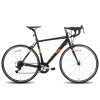Cycle Facts
Road Bike
Road bikes are bicycles designed specifically for riding on paved roads, focusing on speed, efficiency, and comfort over long distances. These bikes are characterized by lightweight frames, smooth tires, and a more aerodynamic geometry compared to other types of bikes, such as mountain bikes or hybrid bikes.
Here are some key features of road bikes:
1. Frame Materials
- Aluminum: Lightweight and stiff, providing good performance at a lower price point.
- Carbon Fiber: Even lighter and offers more vibration damping, making it the choice for high-performance bikes, though usually more expensive.
- Steel: Known for comfort and durability, though heavier than aluminum and carbon.
- Titanium: A balance between steel and carbon, offering comfort and lightness with great durability.
2. Geometry
Road bikes typically have a geometry designed to allow the rider to be in a more aerodynamic and efficient position. This usually means a more aggressive riding posture, with a lower handlebar and higher saddle. Some bikes have a more relaxed geometry to offer additional comfort for long rides.
3. Tires
Road bikes use narrow tires (usually between 23mm and 28mm wide) with a smooth tread pattern. These tires help reduce rolling resistance, allowing the bike to glide smoothly on paved surfaces.
4. Gearing
Road bikes generally have multiple gears (shifters and derailleurs) to accommodate various terrain, allowing the rider to easily adjust their cadence and effort. Most modern road bikes feature 2x or 1x drivetrains:
- 2x: Double chainring at the front (more gears for wider range).
- 1x: Single chainring with a wide-range cassette (simpler setup, fewer parts).
5. Brakes
- Rim brakes: Traditional brake system where the brake pads clamp onto the wheel rim.
- Disc brakes: More modern and provide better stopping power in all weather conditions, especially in wet or hilly conditions.
6. Handlebars
Road bikes typically feature drop handlebars, which allow for multiple hand positions and a more aerodynamic riding posture. This is a key design element for long-distance riders and racers.
7. Weight
Road bikes are typically built to be light, with higher-end models often weighing in at under 8 kg (18 lbs). Lightweight frames and components reduce the overall weight, improving acceleration and climbing ability.
8. Types of Road Bikes
- Endurance bikes: Designed for long-distance comfort with a slightly relaxed geometry. These bikes are ideal for riders who want to ride long hours without too much fatigue.
- Racing bikes: Built for performance and speed, with an aggressive geometry to maximize aerodynamics and efficiency. These bikes are lighter, stiffer, and more responsive.
- Gravel bikes: A mix between road bikes and mountain bikes, designed for riding on a variety of surfaces, including gravel roads and light trails. They tend to have wider tires and more relaxed geometry.
- Touring bikes: Built for long-distance travel, with features like rack mounts for carrying gear, more stable geometry, and durable components.
9. Price Range
- Entry-level: Around $500–$1,500, these bikes are good for casual riders or those just getting into road cycling.
- Mid-range: $1,500–$3,000, offering better components, lighter frames, and improved overall performance.
- High-end: $3,000–$10,000+, offering advanced materials (e.g., carbon fiber), premium components, and precision engineering for competitive athletes and enthusiasts.
Popular Road Bike Brands:
- Specialized
- Trek
- Cannondale
- Bianchi
- Giant
- Cervélo
- Pinarello
- Scott
Whether you’re looking for a bike to get into cycling, compete in races, or take on long-distance rides, road bikes offer a variety of options suited to different riding styles and preferences.






